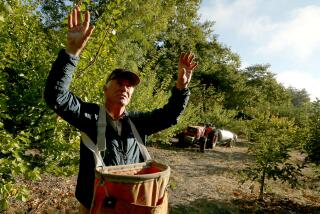Drought Spells Big Changes on the Farms : Economics: Aside from the enormous money loss, the dry spell could alter the face of agriculture in California.
- Share via
Year 5 of the current drought could cost the state’s agriculture industry as much as $2 billion in lost crop value alone, but more importantly it could change the face of farming in California.
After six years of steady growth, agriculture revenues will fall for the first time since the farm crisis of the early 1980s, agricultural economists said. While the state’s economy as a whole will not be decimated, rural towns in the Central Valley--already ravaged by the Christmas freeze--will be weakened further.
“The ripple effect will be felt in reduced purchases by farmers of fertilizer and other kinds of supplies,” said Elmer Learn, an agricultural economist at UC Davis. “There will be a reduction in the amount of farm labor required. If farm workers aren’t employed, they’ll have less money to spend in rural grocery and clothing stores and gas stations.”
The very crops grown in California fields will change. As much as 500,000 acres will be left fallow as farmers take land out of production because of the lack of water. Thirstier crops such as cotton and rice--both of which are among the state’s top 20 moneymakers--will be drastically reduced in acreage.
“A lot of people will be hurt,” said Bill Liebhardt, director of the University of California’s Sustainable Agriculture Research and Education Program. “It’s not just the farmers, but all the people in the rural areas who supply those people. There’s probably a substantial ripple effect.”
On Monday, the state Department of Water Resources announced that it will stop immediately all deliveries of water from the State Water Project to California farms. In addition, deliveries from federal water projects are expected to be cut by up to 65%. Most farmers get water from one project or the other.
As a result, water available for agriculture will drop by about 20%; farmers will be dependent on ground water pumped through wells. But four years of drought has sapped the state’s supply of ground water, and wells must be dug ever deeper at greater expense.
Ground water is in such short supply that farmers in the Alta Irrigation District near Fresno are starting to pump up silt instead of water when they drill. And in Monterey County, farmers have pumped out so much of their ground water that they’re finding seawater, said Frank Limacher, an agricultural economist with the California Food and Agriculture Department.
Economists point out that there is no one-to-one relationship between lost water and dropping revenues. While farmers will have at least 20% less water in 1991, agricultural revenues--$17.6 billion in 1989--are not expected to drop much more than 10%. The reason is that when commodities are in short supply, they command higher prices.
Phillip Vincent, an economist and vice president at First Interstate Bancorp in Los Angeles, estimates that 1991 crop losses will probably range from $1 billion to $2 billion.
Warren Johnston, an agricultural economist at UC Davis, pegs the damage at “a billion dollars very easily and maybe substantially more.”
“As innovative as our farmers are and aggressive in trying to cope with a catastrophic problem like this,” Johnston said, “I can’t believe there won’t be any impact on gross revenues even after some commodity prices increase in value.”
Agricultural disasters always result in losers and winners. While the farmer who loses his whole crop is devastated, the farmer who loses only half a crop finds that his products are more valuable.
Alfalfa, which is used for cattle feed, is a good example of this law of supply and demand; it also is a reminder of how interconnected the different segments of agriculture are. Alfalfa is one of the thirstier crops grown in California, and the less water it gets, the less hay an acre of alfalfa yields.
The last four years of drought have reduced alfalfa production and hiked its price about 15%, which is good for alfalfa farmers but bad for cattle ranchers. The drought has also reduced natural pasture, so ranchers are forced to buy more hay at higher prices.
In fact, cattle and calf ranching is one sector of the agricultural economy that has borne the earliest brunt of the drought. The Bureau of Livestock Identification figures that over the last four years of drought, beef cattle herds have declined by 32%, said Less Guthrie, president of the California Cattlemen’s Assn.
“Many people are starting to move their cattle out of state to new pasture, or purchase additional hay supplies, which are becoming very, very expensive,” Guthrie said. “Or they’re liquidating and selling their cattle.”
In 1988, cattle and calves brought in $1.62 billion wholesale and were the No. 2 agricultural commodity in the state behind dairy products; in 1989, they brought in $1.5 billion and dropped to No. 3 behind grapes.
The cotton industry is crying, too. Gene A. Lundquist, vice president of Calcot Ltd., a growers’ cooperative, predicts that in 1991 cotton growers will plant about 350,000 fewer acres of cotton--a drop of more than 30%--and will lose $300 million.
“There’s going to be a large unemployment factor as well, as growers lay off farm laborers,” Lundquist said.
Officials at Paramount Farming Co. in Bakersfield decided two weeks ago that the company will idle between 20,000 and 25,000 acres of row crops, mostly cotton. The company estimates it will need 700 fewer seasonal employees.
“There’s no way we’re going to be able to find water at a reasonable cost to farm that (acreage) this year,” said William Phillimore, Paramount executive vice president. “That’s gone. It will be fallow for the year.”
Paramount also cultivates 40,000 acres of almonds and pistachios. Of that, about 25,000 acres have no water supply other than the State Water Project.
“If we do not find any water for them, they will almost certainly die,” Phillimore said.
Kern County, where Paramount farms, is the area hardest hit by the state’s decision to cut off agricultural water. For farmers, 1991 will be a disaster at best, according to the county water agency.
The area also provides a clear picture of how far drought damage could reach in the state as a whole.
An estimated 200,000 of Kern County’s richest acres have no water except that provided by the State Water Project. That area accounts for more than a quarter of the county’s crop production, and nearly half of the acreage has permanent crops such as almonds, pistachios, tree fruits and grapes.
If the trees and vines can get enough water to stay alive, the county will sustain only $395 million in direct crop loss and $190 million in sales and revenues for agricultural support services, said Robert B. McKusick, an agricultural consultant for the county water agency.
If the trees cannot be irrigated and they die, McKusick estimates that the loss will rise to $8.4 billion. It breaks down as follows: $4 billion for tree loss and lost revenues over the life of the orchard; $200 million in additional crop loss for other commodities grown in the area; $1.9 billion lost in sales from support industries, ranging from trucking to fertilizer; $1.6 billion in lost farm wages and salaries; $715 million in lost salaries for other industries.
“People don’t realize the magnitude we’re talking about for the state of agriculture,” McKusick said. “It’s probably a catastrophe that’s never been equaled in agriculture for Kern County.”
If orchards are allowed to die for lack of water, McKusick predicts that 7,900 farm jobs would be lost, along with 3,900 additional jobs in other industries.
“The real disaster is if those trees die, you end up carrying a good part of that job loss into the future,” he said.
Not all farmers in the drought-stricken Central Valley are simply cutting back their operations as an answer to the five-year drought; many are leaving the state. According to the CDFA’s Limacher, many vegetable growers are finding greener pastures--and more water--in Colorado and Arizona.
Kenny Evans, vice president of the Arizona Farm Bureau, said that increasing regulation started chasing farmers from California to Arizona as early as 10 years ago. But the flow of farmers is increasing, he said, and the drought is the reason.
“We’ve seen a 250% increase in acreage in the past decade,” Evans said. “We’ve gone from about 20,000 acres of winter vegetables to nearly 70,000 acres. The number of entities has grown from four major vegetable players to 22 major vegetable players. To my knowledge, they’re all from California.”
FARM REVENUES
Gross farm revenues for California over the last decade:
YEAR AMOUNT 1989 $17.6 billion 1988 $16.6 billion 1987 $15.8 billion 1986 $14.8 billion 1985 $14.3 billion 1984 $14.4 billion 1983 $13.2 billion 1982 $14.5 billion 1981 $14.1 billion 1980 $14.0 billion
Source: California Department of Food and Agriculture
NOTE: This chart shows that even through the drought, farm revenues have risen, not dropped. The reason is that farmers have been pumping ground water to keep going. But ground water is severely depleted and will not save farmers in 1991.
More to Read
Sign up for Essential California
The most important California stories and recommendations in your inbox every morning.
You may occasionally receive promotional content from the Los Angeles Times.














